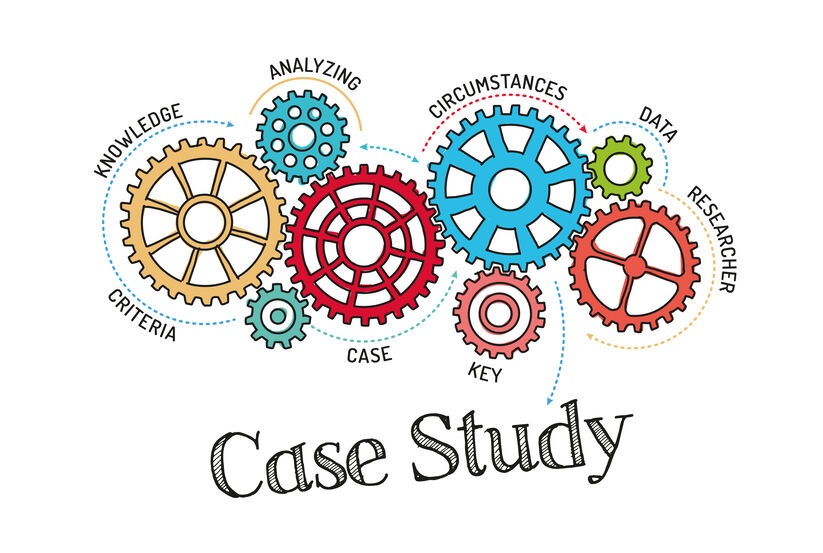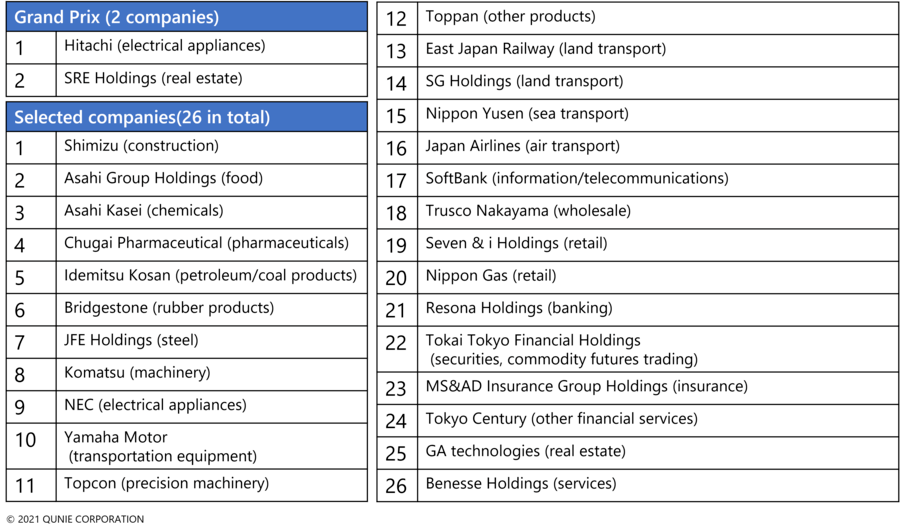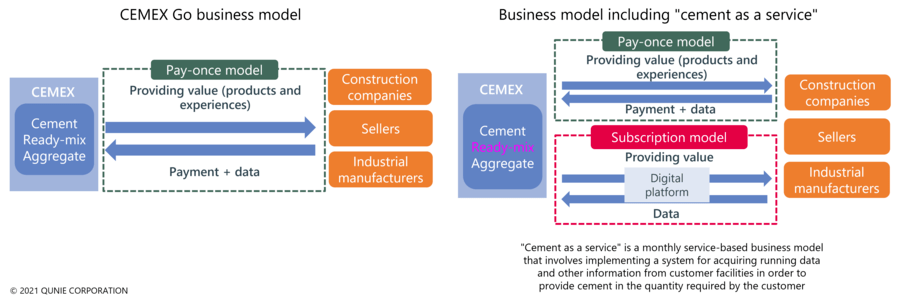Dec 13, 2021
An Encouragement of Introduction to Digital Transformation in Manufacturing
Part 2: Advanced case studies for DX in manufactures overseas
Digital transformation team

In major manufacturing companies with long history, they have built a company culture based on the trust cultivated with customers and business partners, the mindset of employees towards manufacturing products, and a company philosophy shared among executives. Companies have grown and developed their businesses thanks to this company culture. Amid the rapidly changing business environments, however, past successes are causing some companies to delay in decision-making for reasons such as a lack of internal consensus and the invisibility of return on investment. Though it has long been said that a company is capable to exist for 30 years without changes in business form, business model, people and organization, the average lifespan of companies that filed for bankruptcy in 2020 was 23.3 years [1], signaling the shrinking business longevity. Based on the case studies of major non-Japanese companies with more than 100 years of history, we look at how companies should promote corporate transformation to ensure their business longevity.
Advanced DX case studies
The Ministry of Economy, Trade and Industry (METI) and the Tokyo Stock Exchange (TSE) have jointly selected “Digital Transformation Stocks (DX Stocks)” from among TSE-listed companies, and released a list of the “DX Stocks 2021” featuring 28 companies along with “Noteworthy DX Companies” that recognized 20 companies. According to METI, these companies “are not only introducing exceptional information systems and utilizing data, but also boldly taking efforts to change business models and management practices in a continuous manner based on digital technologies” and “are expected to play leadership roles in their various industries.” METI has published a report on the details of activities implemented by selected companies [2], which will be a very useful reference for businesses aiming to promote DX initiatives from now on. Thus, DX is moving forward steadily among some Japanese companies.
List of companies selected for DX Stocks 2021 [3]

According to "DX Report 2" published by METI in December 2020, however, only 5% of Japanese companies have undertaken digital transformations in a companywide and sustainable manner [4]. In reality, many companies are not making progress in DX because they are unable to imagine what kind of result they can expect by implementing DX.
Out of a number of advanced DX case studies of foreign companies, we pick up two major non-Japanese companies with more than 100 years of history to showcase the background, outline, results, and success factors. We hope you will be able to visualize more clearly what you can expect as a result of DX initiatives by learning about the cutting-edge DX case studies.
Advanced case studies for DX in manufacturing overseas: (1) CEMEX
Background of initiatives
The first case study focuses on the DX initiatives at CEMEX [5], a major cement maker that has the fifth largest global market share with over 110 years of history.
In recent years, the cement industry has seen the rise of many players in ready-mixed concrete (ready-mix concrete) for construction sites especially in emerging countries, and the price competition has intensified. As a result, these manufacturers including CEMEX are now required to establish competitive advantage other than price. Moreover, the cement makers are required to accommodate the needs of customers in the construction industry who want to receive cements as quickly as possible when needed. Meanwhile, as actions to address climate change has become an important factor for companies to gain a competitive edge, it is required to reduce the amount of cement-based waste loss and to cut greenhouse gas emissions during the cement production processes. For these reasons, CEMEX launched a digital platform called CEMEX Go to transform their cement business from a pay-per product model to a cement service business, aiming to deliver the required amount of main products such as cement and ready-mix concrete when needed to the designated location (construction site) within four hours after receiving orders.
Outline of initiatives and results of activities
In 2017, CEMEX launched a digital platform called CEMEX Go, which centrally manages ordering, shipping, delivery tracking, payments and transaction records for ready-mix concrete products. Though it used to take hours to place orders, check transaction records and confirm the shipping status, CEMEX Go enables customers to get it done in just a few minutes, realizing a cement version of just-in-time (JIT) inventory system. The platform has over 33,000 users in 21 countries where CEMEX operates. The repeat customer rate among regular users is up to 96%, leading to customer retention while preventing customer defection.

* Created by QUNIE based on StreetInsider.com “Form 6-K CEMEX SAB DE CV For: Mar 20” [6]
Future activities
CEMEX is leading the supply chain platform “OpenBuilt” for the construction materials industry with the aim of providing a new value to boost customer satisfaction. In addition to CEMEX Go, the company is also accelerating efforts to secure customers through the “Cement as a service” subscription model by installing sensors in customers’ facilities to supply the necessary amount of cement when needed.

* Created by QUNIE based on the CEMEX website (https://www.cemex.com/web/cemex-go)
Advanced case studies for DX in manufacturing overseas: (2) BASF
Background of initiatives
The second case study focuses on the DX initiatives at BASF [7], the world’s largest chemical manufacturer established in 1865 when they started to produce synthetic dyes.
Amid changes in the business environment such as the commodification of products, rapidly intensifying competition in developing countries, rising customer demands for lower prices, it has become inevitable for BASF to set their business apart from the competitors. On the other hand, BASF has already acquired a significant market share in the field of automobile coatings and has been continually designing new colors as a Tier 1 supplier in collaboration with automotive manufacturers, currently producing over 600 colors in total.
Therefore, while refining its existing competitive advantages, BASF has built the exterior color design support digital platform called AUROOM for automobile manufacturers to optimize everything from design work to painting processes, aiming to increase the product value of customers by capitalizing on digital technology.
Outline of initiatives and results of activities
BASF introduced the AUROOM in 2018 as a platform for the photo-realistic digital visualization of automobile exterior colors - one of the key elements to affect automotive value. It enables automobile designers to access the color database in this coating platform and check desired colors in a 3-D CAD application (3-D shape design support tool). In addition, the AUROOM provides quality control services in painting processes, which are essential to ensure that the selected coating color can be replicated in the customer’s color coating line. The digital data sharing service is also provided to streamline operations.
With the launch of the AUROOM, BASF is seeking a transformation of business model from selling coating colors (selling products) to adding value to automotive (selling experiences). By optimizing automobile manufacturers’ design work, the platform has been contributing to lead to a long-term partnership.

* Created by QUNIE based on “BASF introduces AUROOM™, a platform for the digital visualization of automotive exterior colors” [8]
Future activities
BASF is committed to providing high-performance coating system (such as water-based coatings) and expanding services that create value for customers.
Factors for success in the two case studies
The reason why these two companies were able to implement corporate reforms is not simply because they successfully developed the digital platforms for their services. It is possible to say that they advanced reforms from the perspective of what kind of value they could provide to customers’ challenges in order to further grow their core businesses (ready-mix concrete and coatings, respectively).
In the case study of CEMEX, the company paid attention to the customers’ issues of productivity decline due to a need to wait at the construction site for ready-mix cement that did not arrive when needed, and solved the problems by providing a digital platform to realize JIT for cement. In the case study of BASF, when it comes to prototyping a new color coating, in order to address the customers’ problems of having to bear significant cost and man-hour to produce real sample coatings and check the color tone by painting automobiles, the company offered a solution by providing a digital platform that can replicate the same color tone as the actual coating.
In this way, each company has utilized digital technology to leverage its strengths to create even greater value. In addition, their initiatives did not intend to design and build the current digital platform from the beginning. As for the CEMEX Go, they thought it would be unrealistic to design a service that would replace analog operations implemented by thousands of companies from the start. Therefore, they released the service with the bare minimum functions to solve the issues faced by customers during the early planning process. After launching the service, they aimed at agile extension based on customer requests.
Conclusion
The two companies’ efforts did not create entirely new and unique products and services, nor did they deal with services incorporating entirely new, cutting-edge digital technology. Instead, they have been expanding their business domains by combining digital technology that had already been widely used and utilizing the data collected from it. This would be a great help for manufacturing industry that is looking to tackle DX initiatives in the future. The quality of products used to be an important factor to differentiate themselves from other companies to increase revenues. However, in recent years, customer needs have more diversified, and quality alone can no longer achieve differentiation. Companies are increasingly required to offer value that can meet diverse customer needs.

To create new value this way, it is vital for companies to take a customer-oriented perspective and think about what customers are struggling with and what they are seeking, and to provide value that goes beyond customers’ expectations. I believe this is truly an altruistic mindset that esteems others over oneself, and such a mindset has been passed down by successful companies in recent years as they continue to grow and expand their businesses. Needless to say, it is important to grow and expand one’s own business. However, I hope to see many more companies implementing and accelerating DX initiatives across Japan by considering DX from the perspective of how their company should undergo transformation in order to enhance growth and expansion of customers as well as the entire value chain.
In the next article of this series, I am going to explain some thinking methods that can be helpful in promoting digital transformation, including design thinking and art thinking.
- [1] Tokyo Shoko Research (2021), “2020 Survey on Bankruptcies Among ‘Established’ Companies with at Least 30 Years of History”, https://www.tsr-net.co.jp/news/analysis/20210203_01.html, (retrieved on December 8, 2021) (in Japanese).
- [2] Ministry of Economy, Trade and Industry (2021), “Digital Transformation Stocks (DX Stocks) 2021”, https://www.meti.go.jp/policy/it_policy/investment/keiei_meigara/dx-report2021.pdf, (retrieved on December 08, 2021) (in Japanese).
- [3] Ministry of Economy, Trade and Industry (2021), “‘DX Stocks 2021’ and ‘Noteworthy DX Companies 2021’ Selected”, https://www.meti.go.jp/press/2021/06/20210607003/20210607003.html, (retrieved on December 08, 2021) (in Japanese).
- [4] Ministry of Economy, Trade and Industry (2020), “DX Report 2 (Interim Report)”, https://www.meti.go.jp/press/2020/12/20201228004/20201228004-2.pdf, (retrieved on December 08, 2021) (in Japanese).
- [5] CEMEX: A cement company headquartered in Monterrey, Mexico. One of the major players in cement, alongside the Holcim Group and HeidelbergCement. It shipped 78 million tons of cement worldwide in 2008, and boasts a cement production capacity of 96.7 tons (in 2007). This company has placed particular focus among the major players in cement to make active acquisitions and expand its size.
- [6] StreetInsider.com, “Form 6-K CEMEX SAB DE CV For: Mar 20”, https://www.streetinsider.com/SEC+Filings/Form+6-K+CEMEX+SAB+DE+CV+For%3A+Mar+20/15278118.html, (retrieved on December 08, 2021)
- [7] BASF: A general chemical company headquartered in Ludwigshafen, Germany. The company retains some 110,000 employees worldwide, and its portfolio comprises six segments: Chemicals, Materials, Industrial Solutions, Surface Technologies, Nutrition & Care and Agricultural Solutions.
- [8] BASF (2018), News release from December 6, 2018 “BASF introduces AUROOM™, a platform for the digital visualization of automotive exterior colors”, https://www.basf.com/global/en/media/news-releases/2018/11/p-18-369.html, (retrieved on December 08, 2021)







